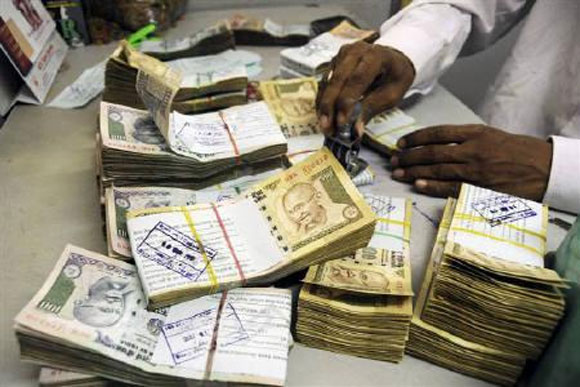
Recent economic data from the US have reinforced belief the US Federal Reserve would stick to its plan of gradual withdrawal of quantitative easing. This has had a repercussion on emerging markets, especially India, which is also grappling with a weak rupee and a burgeoning current account deficit. Chetan Ahya, Asia-Pacific economist at Morgan Stanley, tells Puneet Wadhwa the challenge to meet the fiscal deficit target and the prolonged slowdown in growth raise the risk of a sovereign rating downgrade. Excerpts:
Do you think the concern on US Federal Reserve (US Fed) tapering its bond-buying programme is overplayed?
We believe the Federal Reserve has been actively communicating its intention to taper the quantitative easing (QE) purchases and has announced a framework on what it and other market participants would be watching to assess if it would be on track to taper off.
Our US economics team’s view is the US Fed would start the process of trimming its assets purchases in September, unless the August employment report weakens relative to the July report, or if there is a further shortfall in inflation between now and September.
Click on NEXT for more...

There have been divergent views on China and how its economy is likely to shape up. How is the economic powerhouse placed within BRIC (Brazil, Russia, China and India) nations?
Our view is China’s potential growth has been slowing and would likely slow further as a result of three factors.
First, demographic trends are weakening and would pose a headwind to overall GDP (gross domestic product) growth. These weakening demographic trends would pose a challenge to the pace of economic growth, as these determine the productive labour input toward the production process.
Second, rising per capita incomes meant the economy was approaching the technology frontier, limiting the pace of further catch-up in growth. While there is room for improvement in productivity levels, the pace of productivity gains would likely slow, given the huge progress China has already made on the path to the technological frontier with the help of first-generation reforms and imported technologies.
Third, export demand is likely to remain structurally weak. Given the headwinds from the deleveraging cycle in the developed markets, export growth is likely to remain structurally weaker in the current environment, compared to the pre-credit crisis period.
We believe policymakers are cognisant of these challenges and have already indicated their preference for reforms and the quality of growth over speed of growth. Reforms are required to bring forth a new China, one that features a more balanced growth model and lower, but sustainable growth rates.
Click on NEXT for more...

How much emphasis should one lay on deflation as a risk?
Considering China’s working age population growth was slowing significantly and export demand was likely to remain structurally weak, the rise in leverage for investment in the aftermath of the global financial crisis was unwarranted in many ways.
We believe as China proceeds with its deleveraging cycle and slows the pace of investment growth, it could aggravate the issue of producer price index deflation. Any slowdown in growth will only exacerbate the problem of deflation in producer prices and pose a challenge to the management of real interest rates.
How do you see economies within Asia shaping up?
We believe Asia would face the twin challenges of a potential slowdown in China and the trend of a rising US dollar and rates. We believe every country in the region would be exposed to at least one of these two trends, if not both, which could pose downside risks to the region’s growth outlook.
A slowdown in China’s domestic demand would slow import growth and have an attendant impact on the export growth of its trading partners, particularly Hong Kong, Korea and Taiwan, which count China as their top trading partner. Moreover, China’s strong investment growth trend has played a key role in the trend of industrial commodity prices.
Slower growth in China would imply a slower rate of consumption of commodities, putting downward pressures on prices. In this context, net commodity exporters in the region such as Australia, Indonesia and Malaysia would be hit the most, as their terms of trade would be negatively impacted.
In addition to the challenge of slowing growth in China, we believe the region is facing another challenge in the form of the rise in the US dollar and real rates. We believe rising US interest rates and dollar strength, coupled with the narrower current account surpluses in Asia that have prevailed after the credit crisis, would mean Asia would now face currency depreciation pressures, along with upward pressures on its real interest rates.
Click on NEXT for more...

Do you think all Asian economies are staring at a tough economic phase?
We believe each and every country in the region would face the headwinds from a rising US dollar, with two key implications. First, a rise in real interest rates will slow the pace of credit growth across the region, which would constrain domestic demand growth.
Second, a higher real rate environment without a meaningful rise in real GDP will imply an increase in the debt servicing burden for borrowers. We see this rise in real rates, relative to real GDP growth, as a challenge across the region.
In addition to these two challenges, the region is having an independent challenge of weakening demographics. The demographic trends in China, Korea, Taiwan, Singapore, Hong Kong and, to some extent, Thailand, are reaching an inflection point. These weakening demographic trends would pose a challenge for economic growth, as these determine the productive labour input towards the production process.
In this backdrop, where does India stand? Do you think the policymakers have failed to deliver?
The macro environment in India has been challenging since the credit crisis. The stretched macro stability situation can be attributed to poor policy choices on both the fiscal and monetary policy fronts, with policies kept too loose for too long.
Like most other Asian countries, India pursued an expansionary fiscal policy to push domestic demand (through consumption) in the face of weaker export income. While running a high fiscal deficit for a short period of a year or so after the credit crisis to support growth confidence was justified, continuing with it for four years in a row has left the economy in an unhealthy state.
We believe policymakers’ decision to pursue the bad mix of growth since the credit crisis is at the heart of the problems facing the economy, leading to macro stability risks and slower growth.
Second, RBI has been managing interest rates at levels lower than warranted all through this cycle. Moreover, the easing in the current cycle has already moved at a much faster pace than warranted, keeping real rates on WPI (Wholesale Price Index) very low.
As we have argued previously, the way out of the stagflation-type environment is to change the bad growth mix by first reducing the fiscal deficit and moderating the pace of rural wage growth, while also carrying out policy reforms to improve investment spending. This would help improve the growth mix and productivity dynamics.
Click on NEXT for more...

Is there more pain in store for the rupee?
With the US Fed clearly indicating its intentions to taper quantitative easing, depreciation pressures on the rupee have increased significantly. The increase in the pace of the currency’s fall in May and June was leading to a risk of one-sided bearishness on the rupee, taking it below fair value on our metric of CPI (Consumer Price Index)-based real effective exchange rate (REER).
We believe this forced policymakers to intervene to slow the pace of currency depreciation. We believe to prevent a vicious loop of currency confidence, RBI (Reserve Bank of India) was forced to initiate explicit monetary-tightening to push up short-term rates.
However, these measures would, at best, help reduce the volatility in forex markets; they won’t be able to alter the rupee’s trajectory. RBI’s policy actions, including whether and how quickly they would be able to reverse the quantitative-tightening measures, will depend on external funding and currency-depreciation pressures which, in turn, will depend on US economic data surprises.
We believe India would remain exposed to the trend of the US dollar and real interest rates as long as its current account deficit remains higher than a more sustainable level of 2.5 per cent of GDP and CPI inflation remains higher than seven per cent.
In the next six months, while we expect some moderation in CPI inflation and current account deficit, these would still remain high. During this period, the rupee and the interest rate environment in India will remain highly dependent on the expectations of Fed’s monetary policy action.
How much further could growth rates fall for India? Is a sovereign rating downgrade possible?
GDP growth has already been below five per cent during the quarters ended December 2012 and March 2013, and is unlikely to be any better during the quarter ended June 2013. The recent external macro developments, coupled with weak domestic fundamentals, mean growth could remain weak for at least two more quarters.
A weak growth trend lasting four-five quarters would increase the risk of a vicious cycle, putting India into an extremely vulnerable position and increasing the risk of GDP growth touching 3.5-4 per cent. The challenge to meet the fiscal deficit target and a prolonged slowdown in growth raise the risk of a sovereign rating downgrade.